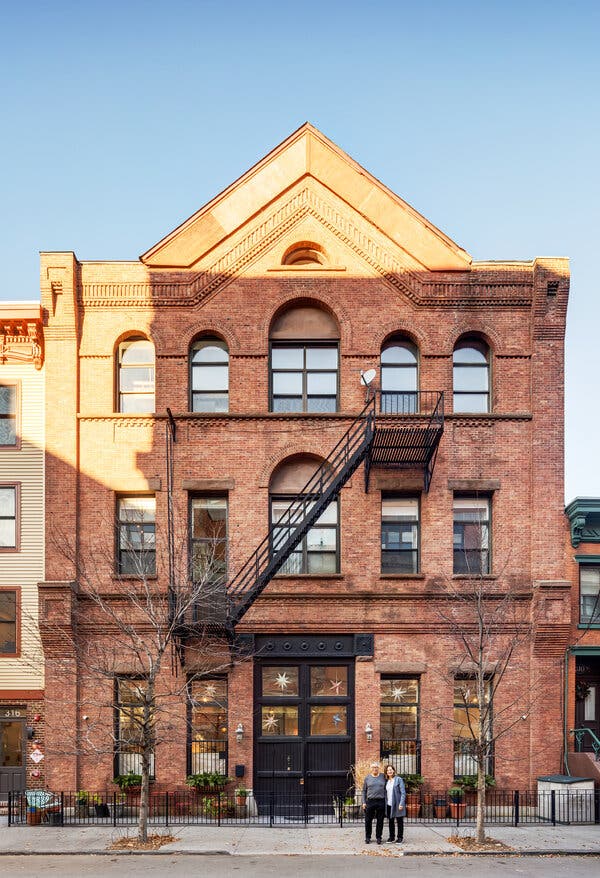The live-work space in Jersey City, N.J., should have been ideal for lockdown. But hindsight born of a pandemic taught them a few things.
When Beverly O’Mara and Mark Uriu converted their loft in Jersey City, N.J., into a live-work space in 2015, they envisioned an airy, open apartment where Ms. O’Mara could have an art studio and Mr. Uriu could work from home on occasion.
They added elements that made sense at the time, installing shoji screens that provided privacy and light, but no sound barrier. And for a while, it worked beautifully.
Then Covid changed everything. Suddenly the couple found themselves working from home full time, trying to come up with makeshift solutions for a space that had already undergone a $250,000 renovation.
For millions of Americans, the pandemic ushered in an era of remodeling, as they used the time at home to remake kitchens, bathrooms and living spaces to accommodate a more domestic lifestyle. (Year-over-year spending on home remodeling grew by more than 9 percent from the third quarter of 2019 to the third quarter of 2021, to $357 billion a year, according to the Harvard University’s Joint Center for Housing Studies.) But what if you renovated before the pandemic — and spent a lot of money on it — and now you had to redo it to reflect a new reality?
Like many others, Ms. O’Mara, 66, and Mr. Uriu, 65, found themselves running headlong into the limits of a design imagined for a prepandemic lifestyle and wondering what modifications, if any, would make their home more functional.
“We’ve seen these interesting new demands put on our spaces, and they are absolutely a byproduct of the shifting lifestyle,” said Jeff Jordan, a Rutherford, N.J., architect who designed the couple’s renovation and is seeing a shift in how homeowners think about renovation.
For those considering remodeling now, Ms. O’Mara and Mr. Uriu’s project offers some useful lessons. The creative, cost-saving strategies they adopted early on, like choosing affordable building materials, are even more valuable now, as material and labor costs are high. But other decisions they made have proved problematic.
Here’s what hindsight born of a pandemic taught them about renovating.
Creating a Functional Live-Work Space
Ms. O’Mara and Mr. Uriu bought their 2,800-square-foot condo in 2012 for $837,000, moving from a Victorian in Montclair, N.J., where they had raised their children. The Jersey City loft, on a leafy street in the Hamilton Park neighborhood, was dark, as the only windows were along the southern wall. Interior walls closed off the back of the space, blocking natural light and making the kitchen, master bedroom and upstairs rooms feel dim and a little claustrophobic.
The apartment, with its dark wood floors, brassy fixtures and cherry cabinets, had a dismal “’90s New Jersey banker” aesthetic, Mr. Uriu said. But they could see its potential.
It was on the first floor of a 19th-century building that once housed Wells Fargo stagecoaches, and it had ceilings that were nearly 19 feet high, spanned by steel beams. One still had the words “No Smoking” painted in big block letters across it.
“You could remove everything, you could make it a completely empty box and you could build anything you wanted,” said Mr. Uriu, an owner of Uriu Nuance, a Manhattan company that installs interior finishes on high-end renovations.
First, the couple needed to decide how much space to dedicate to work and how much to living. Ms. O’Mara, an artist who works in mixed media with materials like paint, paper pulp and ceramics, needed a studio like the one she and Mr. Uriu had built on their Montclair property. Mr. Uriu needed office space so he could sometimes work from home. And they had grown children who lived nearby.
“At a different point in my life, I would have said ‘one-third live space, two-thirds work space,’” Ms. O’Mara said. “But given we have a family and they visit, and grandchildren, we wanted it to be gracious and welcoming to our family and friends.”
They decided to dedicate roughly a third of the space to a studio, reserving the rest for family life. They took down walls, dividing the main floor with a partition wall, with Ms. O’Mara’s studio and the master bedroom on one side and a living area on the other. They turned the upstairs loft into two spaces: a guest room and a home office for Mr. Uriu.
What they learned: Dedicating more space to family life proved to be a prescient decision during the first year of the pandemic, when the grandchildren often visited, using the open living space as a playroom, a respite from their small, cramped Brooklyn apartment.
Other decisions did not hold up as well, particularly putting Mr. Uriu’s office directly above Ms. O’Mara’s studio, with no wall to act as a sound barrier. Desperate for more space and quiet, he turned the 4-by-7-foot closet in the guest room into his office. To enter, he has to duck under a beam.
Two years into the pandemic, he finds himself working in a space that Ms. O’Mara likens to the dwarfed 7 ½ floor in the 1999 film “Being John Malkovich.” When he is seated, Mr. Uriu can look out under the beam and see across the apartment and out the windows to the street below. “When you’re sitting down,” he said, “you don’t feel like you’re in a closet.”
Plenty of Light, Not Much Silence
Another goal of the renovation was to bring light into the apartment from the windows along the front wall. “We identified early on that if we wanted to make this place work, we had to figure out how to get the light from this one facade all the way back,” Mr. Uriu said.
They added two 4-by-4-foot windows above the front door. But interior walls still blocked light to the back of the apartment, and “the upstairs rooms felt like tombs,” Ms. O’Mara said.
Mr. Uriu, who is of Japanese descent and wanted to incorporate a Japanese aesthetic, considered translucent shoji screens, which could provide privacy and filtered light. Working with Mr. Jordan, he designed screens that would open along a track behind a balcony railing of thin cedar slats, designed by Ms. O’Mara. Close the screens and the rooms are private, with light filtering through; open them, and someone upstairs has a bird’s-eye view of the apartment below.
“If you’re standing on the floor in the main room and the lights are on in the room above, it’s almost like a streetscape,” Mr. Uriu said. “It reminds me of being on intimate streets in Kyoto, where you literally have screens with light coming through. You have a sense of a different life happening.”
In the middle of the apartment, they added a partition of cabinets running the length of the space, from the entrance to the back of the kitchen, dividing the apartment in two, but allowing light to pass above.
They also lightened the feeling of the space by installing new lighting and finishes, painting the steel beams a pale gray and the ceiling white, and bleaching the wood floors. Mr. Jordan added an LED strip to the beams for uplighting and used extension rods to suspend track lights from the high ceilings.
What they learned: Those shoji screens and partition walls provided light, but at the cost of sound reduction. With no sound barriers, the couple have spent the past two years desperate for quiet and separation.
There were days when Mr. Uriu was on the phone trying to salvage his business, which was collapsing during the initial shutdown (it has since recovered), while Ms. O’Mara was trying to keep the attention of children as she taught art classes over Zoom, with nothing but shoji screens separating them.
“Suddenly sound became an issue. He couldn’t be screaming about the PPP loan — not that he screamed, but he was really intense,” she said, while she was in the middle of a class.
There is a solution, but the couple hasn’t committed to it yet. They could replace the screens with translucent glass and acoustically detailed sliding doors with an interlock or gasket to help reduce sound transmission, said Mr. Jordan, the architect. “The beauty of the shoji is the transparency for light, but you can’t see through it,” he said. “The drawback is that it’s paper thin, so you hear everything.”
The Quest for Affordable Materials
When Ms. O’Mara and Mr. Uriu designed the space, they kept the budget down by retaining the original floor plan, reusing some existing materials and finding affordable new ones — low-cost finishes in keeping with their modern, minimal aesthetic.
They kept the high-end kitchen appliances, including a wine refrigerator and a Viking stove with a water filler, but replaced the cherry cabinets with simple white ones from Ikea. They bought a stainless-steel utility sink for Ms. O’Mara’s studio from a restaurant supply store on the Bowery in Manhattan. They built the bookshelves, cabinets and the partition wall out of AC plywood, a construction material not typically used for finishes. “It’s a workhorse material,” Mr. Jordan said, but “when thought about differently, it can become quite beautiful.”
The couple went to a lumber yard to select the plywood, looking for a cut with an interesting grain. The one they chose had “a soothing, psychedelic rhythm to it,” Ms. O’Mara said.
Had they been renovating during the pandemic, when lumber prices soared, Mr. Jordan said, they might not have chosen plywood. (Lumber prices rose almost 90 percent during the year ending in April 2021, the largest 12-month jump since January 1927, when data were first collected, according to the U.S. Bureau of Labor Statistics.) But the couple’s willingness to choose unconventional materials allowed them to find savings where others might not have.
For a few splurges, they enlisted the help of friends in the design industry. Art in Construction, in Brooklyn, designed the pigmented plaster waterfall counter on the kitchen island and the veneer-plaster vanity counter in the master bathroom. An ironworker friend made the banisters for the two staircases.
Mr. Jordan looked for creative ways to add storage to the open space, installing built-in bookshelves on the staircases, along with a Putnam rolling ladder. Other playful flourishes included a hammock, a pulley system for storing bikes, and a seat made of netting that dangles from the banister on the landing of the studio staircase, creating an unexpected spot to read.
What they learned: Almost seven years after the renovation, the plywood and the cabinets have held up well. And while the couple’s tastes are different from those of the previous owners, they have come to appreciate the elements they retained, including the two bathrooms with traditional wainscoting and glass mosaic tile.
Despite the frustrations of the past two years, and the mistakes they made, the overall design has served them well during a trying time, Ms. O’Mara said: “The truth is, it’s a great house. It’s a great home. I love that it’s a live-work space.”
For weekly email updates on residential real estate news, sign up here. Follow us on Twitter: @nytrealestate.



























